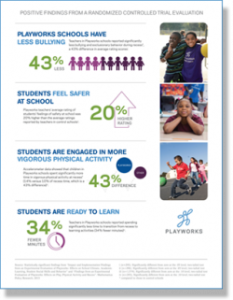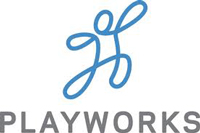 Much has been said of late about the importance of physical activity during the school day as being key to supporting academic performance in students. And there is plenty of research to back this assertion up. In May, the Institute of Medicine issued a report calling upon the nation’s schools to boost their efforts to get students moving.
Much has been said of late about the importance of physical activity during the school day as being key to supporting academic performance in students. And there is plenty of research to back this assertion up. In May, the Institute of Medicine issued a report calling upon the nation’s schools to boost their efforts to get students moving.
Now a new study from John W. Gardner Center at Stanford University and Mathematica Policy Research highlights the widespread benefits of recess programs such as Playworks that do more than just provide a break in the day.
[quote align=”center” color=”#999999″]”These findings tell us there is much more to recess than meets the eye,” said Nancy Barrand, senior program officer for the Robert Wood Johnson Foundation, which sponsored the research trial. “If a single program at recess can prevent bullying, help students be more physically active, and give teachers more time to teach, it suggests that schools ought to take a much harder look at what is happening on their own playgrounds at recess.”[/quote]Research was conducted to evaluate the effectiveness of Playworks during the 2010-11 and 2011-12 school years. Key findings in the report include:
- Less Bullying. Teachers in Playworks schools reported significantly less bullying and exclusionary behavior during recess compared to teachers in control schools—a 43 percent difference in average rating scores.
- Increased Feelings of Safety at School. Playworks teachers’ average rating of students’ feelings of safety at school was 20 percent higher than the average rating reported by teachers in control schools.
- More Vigorous Physical Activity. Accelerometer data showed that children in Playworks schools spent significantly more time in vigorous physical activity at recess than their peers in control schools (14 percent versus 10 percent of recess time—a 43 percent difference).
- Ready to Learn. Teachers in Playworks schools reported spending significantly less time to transition from recess to learning activities (34 percent fewer minutes).




